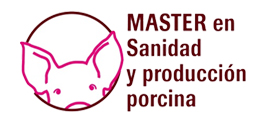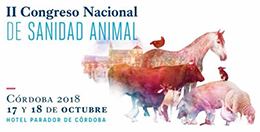October, 2018 news
October 31st, 2018
Via publiDB
VetenVIVO. FormaciĂłn de profesionales veterinarios. 2018 edition
Communications in this event:
- Lesiones bucales en pequeños animales
- Lesiones oncológicas en pequeños animales
- Enfermedades reproductivas en Bovinos. Las olvidadas
- PatologĂa intestinal en pequeños animales
- PatologĂa respiratoria en bovinos
- Enfermedades Emergentes: Riesgos, Alertas y Prevenciones
- Diagnóstico diferencial enfermedades dermatológicas en pequeños animales
- InspecciĂłn post-mortem: Principales lesiones en ganado vacuno
October 30th, 2018
Via publiDB
Investigadores españoles, cerca de la vacuna contra la peste porcina
Interview in Animal´s Health of Animal´s Health
Un equipo de investigadores españoles liderado por el veterinario JosĂ© Manuel Sánchez-VizcaĂno se encuentra cerca de culminar su proyecto de prototipo de vacuna contra la peste porcina africana…
Read more
October 26th, 2018
Via publiDB

Máster Universitario en BiologĂa Sanitaria
Communications in this event:
October 25th, 2018
Via publiDB

InmunologĂa porcina básica y aplicada
Conference in Dialógos sobre el Cerdo Ibérico 2018
Related news in other media:
- Éxito de convocatoria de los "Diálogos sobre el cerdo Ibérico 2018" de Syva - porcino.info
October 25th, 2018
Via publiDB

Máster Universitario en Sanidad y Producción Porcina. 2018 edition
Communications in this event:
- VacunaciĂłn en jabalĂ: aproximaciĂłn para el control de PPA
- Animales de vida libre como reservorio de enfermedades
- LegislaciĂłn sobre sanidad animal
- EpidemiologĂa: teorĂa y práctica II
- InmunologĂa: vacunas de nueva generaciĂłn
- EpidemiologĂa: teorĂa y práctica I
- Visita al Centro de Vigilancia Sanitaria Veterinaria (VISAVET)
- InmunologĂa. Inmunidad adaptativa I
- InmunologĂa. IntroducciĂłn. Inmunidad natural
- InmunologĂa: Vacunas convencionales
October 24th, 2018
Via publiDB

Current concepts and contents of Veterinary Public Health and Veterinary Health Polic
Revista española de Salud Pública publish this investigation article
Human and veterinary medicine obviously share most concepts and contents. However, both academic and scientific issues and the daily practice of many health disciplines can differ largely between human and veterinary medicine. Such differences can easily go unnoticed among other healthcare collectives or the general public. The aim of the present work was to provide an update, as well as some definitions of what we understand under the terms Veterinary Public Health and Veterinary Health Policy…
Read more
October 24th, 2018
Via publiDB
La peste porcina africana amenaza de nuevo ÂżEstamos preparados?
Conference in Jornada informativa: La peste porcina africana amenaza de nuevo ÂżEstamos preparados?
Related news in other media:
- Investigadores españoles desarrollan un prototipo de vacuna contra la Peste Porcina Africana - revistajaraysedal.es
- Investigadores españoles, a punto de terminar una vacuna contra la peste porcina - club-caza.com
- JosĂ© Manuel Sánchez VizcaĂno: “Bioseguridad sobre todo" - 3tres3.com
- VISAVET y CSIA-INIA colaboran en el desarrollo de una vacuna frente a la peste porcina africana - eurocarne.com
October 23rd, 2018
Via publiDB

Ant(6)-I genes encoding aminoglycoside O-nucleotidyltransferases are widely spread among streptomycin resistant strains of Campylobacter jejuni and Campylobacter coli
Frontiers in Microbiology publish this investigation article
Thermotolerant Campylobacter species C. jeuni and C. coli are actually recognized as the major bacterial agent responsible for food-transmitted gastroenteritis. The most effective antimicrobials against Campylobacter are macrolides and some, but not all aminoglycosides. Among these, susceptibility to streptomycin is reduced by mutations in the ribosomal RPSL protein or by expression of ANT(6)-I aminoglycoside O-nucleotidyltransferases. The presence of streptomycin resistance genes was evaluated among streptomycin-resistant Campylobacter isolated from humans and animals by using PCR with degene…
Read more
October 22nd, 2018
Via publiDB
Mitos y verdades de la tuberculosis bovina
Conference in Jornada TĂ©cnica anual de Veterinarios Asociados SC
October 22nd, 2018
Via publiDB

22nd Annual ESDAR Conference 2018
Communications in this event:
- Equine sperm cryopreservation efficiency optimization by colloidal centrifugation
- Detection of Taylorella asinigenitalis by real time PCR in different breeds of Equus asinus in Spain
October 20th, 2018
Via publiDB
Bioterrorismo, amenazas actuales y de futuro
Conference in IX Simposio de la AsociaciĂłn Española de VacunologĂa
October 19th, 2018
Via publiDB
Varamientos y detección viral en cetáceos. Su relación epidemiológica
Oral communication in XI Congreso Sociedad Española de Cetáceos
October 18th, 2018
Vía biologicas.ucm.es
Visita de los alumnos al Centro de Vigilancia Sanitaria Veterinaria de la UCM
Grado BiologĂa
Visita de los alumnos de la asignatura de MicrobiologĂa ClĂnica y EpidemiologĂa (Grado en BiologĂa, MenciĂłn Biosanitaria, grupo de tarde) al Centro de Vigilancia Sanitaria Veterinaria de la UCM. Durante nuestra visita, el pasado dĂa 9 de octubre de 2018, recibimos una charla sobre Bioseguridad en el Laboratorio de la mano de MarĂa Mazariegos y David Duque del Servicio de Calidad y Bioseguridad, cuyo principal objetivo fue conocer el equipamiento de Bioseguridad como elemento imprescindible de la seguridad biolĂłgica en el laboratorio. Especialmente interesante fue la demostraciĂłn que…
October 17th, 2018
Via publiDB
Curso de actualizaciĂłn de tuberculosis bovina. 9ÂŞ edition
Communications in this event:
- Coloquio. El veterinario como pieza importante en la erradicaciĂłn de la tuberculosis bovina
October 17th, 2018
Vía The Financial Times
Deadly disease rattles Europe`s pig farmers
Outbreak of African swine fever in Belgium
Please use the sharing tools found via the share button at the top or side of articles. Copying articles to share with others is a breach of FT.com T&Cs and Copyright Policy. Email licensing@ft.com to buy additional rights. Subscribers may share up to 10 or 20 articles per month using the gift article service. More information can be found at https://www.ft.com/tour.
https://www.ft.com/content/899b4866-cd38-11e8-b276-b9069bde0956
Spain has already experienced ASF, which was eradicated in 1995 after 35 years. JosĂ© Manuel Sánchez-VizcaĂno, animal health professor from Madrid’s Complut…
October 11st, 2018
Servicio de Informática y Comunicación
The rector of the UEx receives the Civil Order of Alfonso X El Sabio and the CRUE gold medal
Segundo Píriz concludes his stage in the direction of the University of Extremadura
Segundo Píriz Durán, rector of the University of Extremadura (UEx), receives today in Cáceres, the Civil Order of Alfonso X El Sabio, as well as the first Gold Medal of the Conference of Rectors of the Spanish Universities (CRUE).…
Read more
October 11st, 2018
Via publiDB

Sensibilidad antibiĂłtica de Pasteurella multicocida de ovino
Degree Final Project defended by Mónica Sánchez Cauce
October 11st, 2018
Via publiDB

Caracterización y detección genética de Enterobacterias resistentes a colistina en muestras de origen animal
Marta Valero Lorenzo defended this Degree Final Project
Justification. Colistin resistance poses a major Public Health concern. The first description of a plasmid mediated gene codifying for colistin resistance took place in 2015, since this year eight genes have been described. Those genes codify for colistin resistance by modifications in Lipid A, target of this antimicrobial in the bacterial cell wall. As a plasmid mediated genes, could imply horizontal transmission of resistance. Besides, colistin classification as “critically important antibiotic for human medicine” by the WHO, and the growth of colistin resistance, stablish the need to de…
Read more
October 11st, 2018
Via publiDB

Prevalencia de la Hepatitis E en cerdo blanco en España
Degree Final Project defended by Sara Carral Irijoa
El virus de la hepatitis E (HEV) es responsable de casos, endĂ©micos y epidĂ©micos, de hepatitis aguda en humanos en todo el mundo. En paĂses en desarrollo la transmisiĂłn es fundamentalmente a partir del consumo de agua contaminada. En paĂses desarrollados la hepatitis E se considera una enfermedad zoonĂłtica emergente, siendo el consumo de alimentos contaminados, principalmente del cerdo, la principal fuente de infecciĂłn. Es un virus ARN, clasificado en la familia Hepeviridae, que incluye 7 genotipos, 4 principales (1-4), y un octavo genotipo que está propuesto. Los genotipos 1 y 2 sĂłlo…
Read more
October 11st, 2018
Via publiDB
Estamos jugando a la loterĂa con la peste porcina africana
Interview in La Vanguardia of La Vanguardia
El director del laboratorio de referencia en peste porcina africana advierte sobre importar lechones y la superpoblaciĂłn de jabalĂes…
Read more
October 9th, 2018
Via publiDB
Curso sobre Enfermedades Emergentes
Communications in this event:
- Ejemplos actuales de Enfermedades Emergentes
- Vigilancia de enfermedades emergentes y ComunicaciĂłn en crisis sanitarias
- Enfermedades emergentes y enfermedades desatendidas: generalidades
October 9th, 2018
Via publiDB

Grado de BiologĂa
Communications in this event:
- Bioseguridad en el Laboratorio. asignatura de MicrobiologĂa ClĂnica y EpidemiologĂa
- Visita al centro VISAVET. Asignatura de MicrobiologĂa ClĂnica y EpidemiolĂłgica
October 8th, 2018
Via publiDB
New Research Support Centres and Unique Scientific and Technical Infrastructures website presentation
Conference in PresentaciĂłn del nuevo sitio web CAI - ICTS
Presentation of the new web development for the Research Support Centres (RSC) and Unique Scientific and Technical Infrastructures (USTI) of the Complutense University of Madrid…
Read more
October 5th, 2018
Via publiDB
Pathologic findings and causes of death of stranded cetaceans in the Canary Islands (2006-2012)
PLoS ONE publish this investigation article
This study describes the pathologic findings and most probable causes of death (CD) of 224 cetaceans stranded along the coastline of the Canary Islands (Spain) over a 7-year period, 2006-2012. Most probable CD, grouped as pathologic categories (PCs), was identified in 208/224 (92.8%) examined animals. Within natural PCs, those associated with good nutritional status represented 70/208 (33.6%), whereas, those associated with significant loss of nutritional status represented 49/208 (23.5%). Fatal intra- and interspecific traumatic interactions were 37/208 (17.8%). Vessel collisions included 24/…
Read more
October 4th, 2018
Via publiDB
Theileria equi and Babesia caballi in vitro culture
New article published in VISAVET Outreach Journal
Equine piroplasmosis (EP) is an infectious disease of equids caused by the intraerythrocytic protozoan parasites Babesia caballi (B. caballi) and Theileria equi (T. equi). The importance of this disease is the fact that, after the infection, horses can remain as chronic carriers of the parasites for a long time, being seropositive but showing clinical signs only in cases of immunosuppression or intense exercise. EP involves serious economic losses for the equine industry due to the restrictions in the export of horses to countries free from EP…
Read more
October 4th, 2018
Via publiDB
SituaciĂł de la pesta porcina africana a Europa
Oral communication in Retos actuales del sector porcino: peste porcina, bioseguridad y prescripciĂłn veterinaria
October 4th, 2018
Via publiDB
Zoonosis transmitidas por garrapatas
Conference in 4º Congreso Nacional de la Asociación Española de Bioseguridad (AEBios)
October 3rd, 2018
Via publiDB

Master in Translational Medicine Research. 2018-2019 edition
Communications in this event:
October 3rd, 2018
Via publiDB
Current situation of ASF worldwide and status of development of a possible vaccine
Oral communication in Swine Seminar
October 1st, 2018
Via publiDB
Response of goats to intramuscular vaccination with heat-killed Mycobacterium bovis and natural challenge
Investigation published in Comparative Immunology, Microbiology and Infectious Diseases
Caprine TB causes chronic disease with severe economic and health consequences. We assessed the effect of intramuscularly administered heat-inactivated Mycobacterium bovis (M. bovis) on 20 kid goats (10 vaccinated, 10 controls), naturally exposed to M. caprae through close contact with infected goats. At necropsy, visible TB-compatible lesions were recorded in all animals with the exception of 1 control and 2 vaccinated goats. The median of the total lesion score was 9 (IQR 3-13.5) and 5 (IQR 3-6.75) in control and vaccinated goats, respectively (median lesion reduction 44.4%, p = …
Read more
October 1st, 2018
Via publiDB
Limited performance of MALDI-TOF for identification of fish Aeromonas isolates at species level
Investigation published in Journal of Fish Diseases
The aim of this study was to evaluate the usefulness of the MALDI-TOF MS to identify 151 isolates of Aeromonas obtained mostly from diseased fish. MALDI-TOF MS correctly identified all isolates to the genus level but important differences in the percentage of isolates correctly identified depending on the species were observed. Considering exclusively the first identification option, Aeromonas bestiarum, Aeromonas hydrophila, Aeromonas salmonicida, Aeromonas veronii and Aeromonas sobria were the best identified with results >95%. However, considering the first and second identification options…
Read more
October 1st, 2018
Via publiDB
Management of hunting waste as control measure for tuberculosis in wild ungulates in south-central Spain
Transboundary and Emerging Diseases publish this investigation article
In recent decades, habitat change and the intensive management of wild ungulates for hunting have led to an increase in their populations in south-central Spain. This implies a higher generation of hunting waste, which can favour the transmission of infectious diseases, including tuberculosis (TB). The aim of this study was to assess the usefulness of the proper disposal of hunting waste as TB control measure in wild boar (Sus scrofa) and red deer (Cervus elaphus) during the 2008/2009 to 2016/2017 hunting seasons. Blood samples from 664 wild boar and 934 red deer were obtained in 14 game estat…
Read more
October 1st, 2018
Via publiDB

Biosecurity and Prevention of Occupational Risks in the Microbiology Laboratories Course. 2018-2019 edition. 2018 edition
Communications in this event:
- Supuestos prácticos de Bioseguridad. Micobacteriosis
- IntroducciĂłn al Centro de Vigilancia Sanitaria (VISAVET) y a sus instalaciones
- PrevenciĂłn en Riesgos Laborales en los Laboratorios de MicrobiologĂa (Riesgos BiolĂłgicos) III
- PrevenciĂłn de Riesgos Laborales en los Laboratorios de MicrobiologĂa (Riesgos BiolĂłgicos) II
- PrevenciĂłn de riesgos Laborales en los Laboratorios de MicrobiologĂa (Riesgos BiolĂłgicos)
- Equipamiento y métodos de trabajo
- Instalaciones de contenciĂłn
- Bioseguridad y riesgo biolĂłgico



